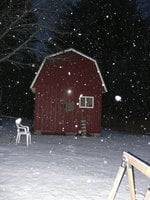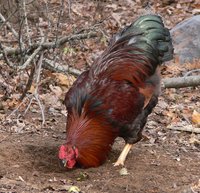How many people still keep their flocks the old fashioned way? Keeping them outside in coops, (with or without runs), free ranging, feeding them kitchen scraps, etc? My chickens are housed outside from the day I get them if bought or shipped, and within a week if I hatch them here. I have progressed from a heat lamp to MHP, but don't have monitors or video cameras in my coop. I did put electric fence around my run after a mink attack this summer.
How about when you have a sick or "special needs" chicken? I usually cull. I want to keep my flock strong and healthy.
So, how do you all raise your chickens?
How about when you have a sick or "special needs" chicken? I usually cull. I want to keep my flock strong and healthy.
So, how do you all raise your chickens?




 - I'd been looking at ground level since they're only 3 weeks old - but it clearly didn't see me as a rescuer
- I'd been looking at ground level since they're only 3 weeks old - but it clearly didn't see me as a rescuer  . I grabbed a bag of food and tried to get the broody come get it but she was staying near the coop
. I grabbed a bag of food and tried to get the broody come get it but she was staying near the coop  . So I lured the rest of the flock with food until they arrived at the cedar; the pullet at the bottom of the pecking order saw her opportunity of course but
. So I lured the rest of the flock with food until they arrived at the cedar; the pullet at the bottom of the pecking order saw her opportunity of course but  the cockerel stepped in to protect the chick.
the cockerel stepped in to protect the chick.  ; on the second it got within sight of the coop and then ran away again; it didn't help that the broody was invisible in the bushes nearby, so I went and drove her out into the open - she finally started co-operating with the rescue
; on the second it got within sight of the coop and then ran away again; it didn't help that the broody was invisible in the bushes nearby, so I went and drove her out into the open - she finally started co-operating with the rescue  ; and on the third attempt the lost chick followed one of the other hens to a spot in sight of the coop and mum. That hen did seem to be consciously helping, because the rest of the flock stayed by the cedar while she headed home with the chick in tow. A bit more calling and chick and mum were reunited, just in time for bed
; and on the third attempt the lost chick followed one of the other hens to a spot in sight of the coop and mum. That hen did seem to be consciously helping, because the rest of the flock stayed by the cedar while she headed home with the chick in tow. A bit more calling and chick and mum were reunited, just in time for bed  .
. 


 I kept the DLM going in my run until that neighbour moved out and took his 15+ nasty mutts along with him. Then I closed the back door permanently and let them all out to free range. Bird morale skyrocketed, and so did their health. I had been having stubborn lice issues, and free range reduced re-infection rates considerably. At the time of this post, it has been coming up on a year without a single louse spotted on my birds.
I kept the DLM going in my run until that neighbour moved out and took his 15+ nasty mutts along with him. Then I closed the back door permanently and let them all out to free range. Bird morale skyrocketed, and so did their health. I had been having stubborn lice issues, and free range reduced re-infection rates considerably. At the time of this post, it has been coming up on a year without a single louse spotted on my birds.

